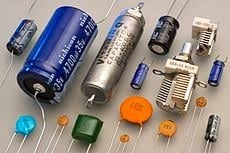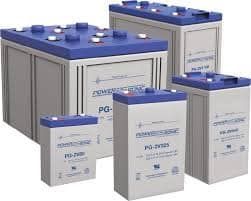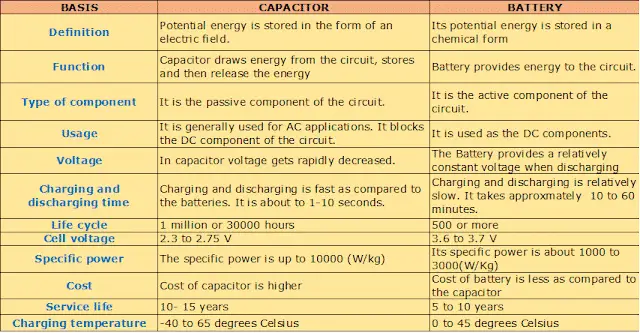What is Capacitor?
A capacitor is a passive two-terminal device that stores electric charge in an electric field. The capacitor has two metallic plates separated by a dielectric medium. The dielectric medium may be paper, electrolytes, mica, tantalum, etc.

When voltage is applied across the capacitor, the capacitor gets charged up to the voltage applied. The charge remains stored in the electric field and when the electric field is removed the stored charge vanishes after a short period of time. The capacitor is a passive component.
What is Battery?
The battery is an active component that supplies energy to the circuit. The battery can be charged by applying the voltage across the battery, and the stored energy can be used later on.

The battery consists of mainly three parts- Anode, Cathode, and Electrolyte. The charging and discharging of the battery take place by chemical reaction. The key difference between capacitor and battery is as given below.

Key Differences between battery and capacitor
- When voltage is applied electric field F=qE is generated between the plates of the capacitor. The potential energy is stored in the capacitor. Whereas, the energy is stored in the form of chemical energy in the battery.
- The capacitor draws energy from the source, stores it till voltage is applied across it, and on switching off the supply capacitor releases the energy. In the case of a battery, it draws energy from the source, and after getting fully charged if the incoming supply gets tripped it delivers energy to the load.
- The capacitor is a passive component. It can not be used as a voltage source. The battery delivers current to the load circuit for a longer time period. That is why the battery is an active component.
- A capacitor is generally used for AC circuits. It blocks the DC components of the circuit. The battery can be charged with a DC supply because the chemical reaction between the electrolyte and the plates takes place in the form of chemical reactions when DC is applied. The battery can not be charged with an AC supply.
- The capacitor discharges quickly because of the lesser time constant. The resistance is approximately zero. In the case of a battery discharges exponentially and discharges slowly.
- Charging and discharging of the capacitor is very fast, and it takes about 1-10 seconds. It takes a large current to charge. The battery charging and discharging time is slow and it takes about 1-2 hrs for charging and discharging the battery. When the battery is fully discharged it is charged on the boost mode of the battery charger, and after attaining a certain voltage the battery is charged in the trickle/float mode of the battery charger.
- The life cycle of the capacitor is more than the battery. The life cycle of the capacitor and battery is 30000 hours and 500 hours respectively. Also, the cost of the capacitor is more than the battery.
- The specific power of the capacitor is about 10000(w/Kg) and the specific power of the battery is 1000 to 3000(w/Kg).
- The capacitor can function in the temperature range of -10 to 65-degree centigrade, whereas in the case of the battery it is 0 to 45-degree centigrade.
- The capacitor is larger in size as compared to the battery.